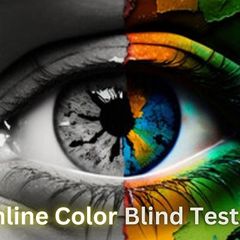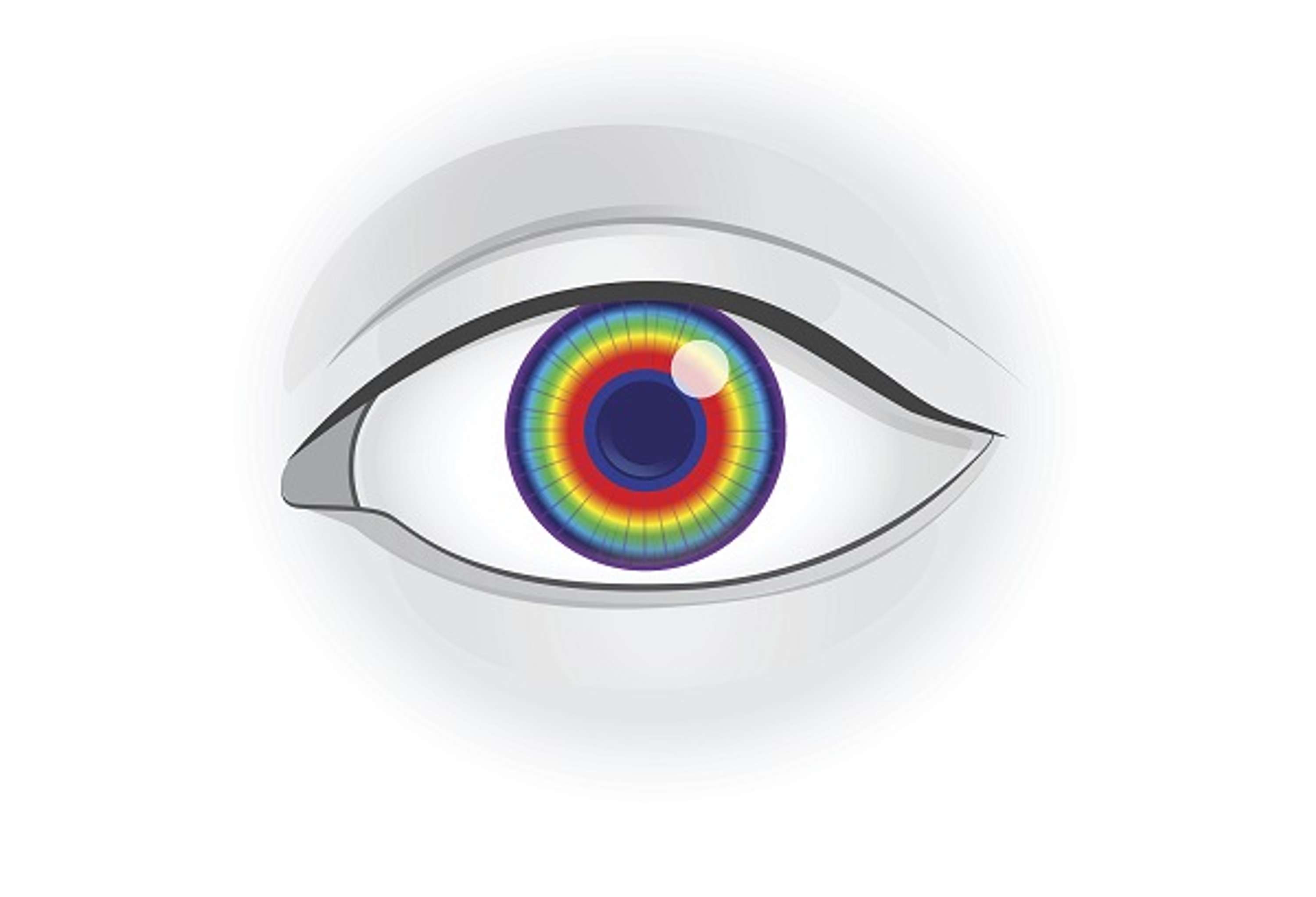In this article, you will learn about the different types of color blindness, but first you need to know what color blindness is. So let's start. Color blindness is simply the inability to recognize and distinguish colors and by doing some color vision test you are able to find out your color blindness problem. The most common form of color blindness makes it difficult to distinguish between red and green. Another type makes it difficult to distinguish between blue and yellow.
People who are totally color blind don't see any color at all, but that's not very common. Color blind people cannot see colors like other people. Most of the time, color blindness is hereditary.
There is hardly any permanent cure, color blindness is more common in men than in women. Red-green color blindness is a broad term for the two most common types of color blindness, deuteranopia and protanopia, affecting the lives and jobs of tens of million people.
If you suffer from any type of color deficiency, you know how difficult it can be to complete some daily tasks, from deciphering seemingly confusing information on a bewilderingly colored chart to distinguishing between red and green lights at an intersection.
History of Color Blindness
In 1798, English chemist John Dalton published the first scientific article about color blindness. That was after he found out that he was color blind.
The article was called "Extraordinary facts relating to the vision of colours". Because of this, the condition is sometimes called daltonism. As of 2009, the word daltonism is used only for the type of color blindness called deuteranopia.
Types of Color Blindness
Color blindness (also spelled colour blindness) or color vision deficiency (CVD) includes a wide range of causes and conditions and is actually quite complex. Usually when people talk about color blindness, they are referring to the most common forms of red-green color blindness, which are genetic conditions caused by a recessive gene on the X-chromosome, but there are other types as well.
Red-green color blindness can be broken down into two main types: Protan-type (“pro-tan”), which is a disorder of the first “prot-” type of retinal cones also called the L-cones, and Deutan-type (“do-tan”) which is a disorder of the second type of retinal cone also called the M-cones.
Protan Color Blindness
Protan Color Blindness (“pro-tan”) is an anomaly of the “L” cones. The “L” stands for Long Wavelength Light, which is generally seen as red light, mainly responsible for seeing red colors. In Protan-type CVD, the spectral sensitivity of the L-cone is shifted toward shorter wavelengths, so that it does not receive enough red light, and receives too much green light compared to a normal L-cone.
Protan-type CVD includes protanomaly, which is a partial shift of the L-cone, and protanopia, which is a complete shift of the L-cone. It is estimated that about 25% of cases of red-green color blindness are of the protan type.
A person with protan type color blindness tends to see greens, yellows, oranges, reds, and browns as being more similar shades of color than normal, especially in low light. A very common problem is that purple colors look more like blue.
Another common issue is that pink colors appear to be gray, especially if the pink is a more reddish pink or salmon color. Another symptom specific to protan color vision deficiency is that red colors look darker than normal.
For example, if red text is printed on a black background, it can be very hard to read because the red appears to be very dark.
Deutan Color Blindness
Deutan Color Blindness (“do-tan”) is an anomaly of the “M” cone. The “M” stands for Medium Wavelength Light, which is generally seen as green light.
In Deutan-type CVD, the spectral sensitivity of the M-cone is shifted toward longer wavelengths so that it effectively receives too much red light and not enough green light.
A person with deutan color vision deficiency may experience confusions between colors such as green and yellow, or blue and purple.
Another common symptom is that green traffic signals appear to be a very pale green or sometimes white. Common color confusion also occurs between pink and gray or white, especially if the pink is similar to a light purple.
Tritan Color Blindness / Tritanomaly
Tritan Color Blindness (“try-tan”) includes tritanomaly and tritanopia. It is also sometimes called blue-yellow color blindness. Tritan color blindness most commonly acquired later in life due to aging of the eye or a medical condition such as glaucoma and is only very rarely inherited from birth.
Tritan color vision is generally characterized by a reduced sensitivity in the blue-sensitive “S” cone cells. “S” stands for Short Wavelength Light. The retinal S-cone cells make up only about 1% of the approximately 6 million retinal cone cells, so when they are damaged or not functioning properly, it can easily cause a degradation to color vision.
Typically a person with a tritan-type color vision deficiency does not see blue colors well, and may have difficulty seeing the difference between blue and green. Cataracts, glaucoma, and age-related macular degeneration can cause symptoms of tritan color blindness.
Another factor that causes reduced sensitivity to blue is the yellowing of the crystalline lens within the eye: these cells do not regenerate and over a lifetime of exposure to light, especially UV light, the lens tends to become yellow in appearance and block the transmission of blue light, interfering with color vision. Eventually this yellowing also leads to cataracts that must be treated surgically.
Monochromacy and Achromatopsia
Monochromacy and Achromatopsia describes a range of conditions that include rod-Monochromacy, S-cone Monochromacy and Achromatopsia. Sometimes these are collectively referred to as types of achromatopsia, as the word “achromat” meaning “no color.” However, not all cases of achromatopsia have “no color” vision. Similar to other forms of color blindness, achromatopsia can be graded as incomplete (partial) achromatopsia or complete achromatopsia (total color blindness).
Achromatopsia is often associated with light sensitivity, photophobia, and glare sensitivity. In some cases, low vision disorders such as progressive cone dystrophy or retinitis pigmentosa can cause a gradual deterioration of color vision that eventually turns into complete achromatopsia.
Trichromats, Dichromats, Monochromats are terms used in the vision science community to refer to different possible configurations of the human visual system having three (tri-), di (two) or one (mono) channel of color information.
However, these terms are simplified to a great extent, because the true capability of a color vision system also depends on the degree of overlap between the channels, “perceptual noise” within the channels, and the cognitive processing capability for deciphering these signals in the visual cortex of the brain.
Most cases of color blindness are considered anomalous trichromacy which means they are effectively operating at somewhere between trichromat (normal color vision with 3 channels) and dichromat (2 channels).
The Color Blind Test is specifically designed to determine your type of red-green color blindness (deutan or protan) and level: mild deutan or protan, moderate deutan or protan, or strong deutan or protan.
However there are limits to what can be tested with a self-administered online test. If you believe that you may have a color vision deficiency, EnChroma recommends getting a complete eye exam by a qualified eye care professional.
Normal Color Vision
A person with normal color vision can typically perceive up to 1 million different shades of colors. Normal color-sighted individuals are Trichromats, meaning that they have three different color sensitive cones in their retina: red, green, and blue. Each of these red, blue, and green cones are sensitive to different wavelengths of light and help to create color perception. The unique separation and overlap work together to enable those with normal color vision to see all the colors of the spectrum.
It is believed that a person with typical red-green color blindness often perceives only 10% as many shades of color as a person with normal color vision.
Causes of Color Blindness
There are several different problems that can cause color blindness.
If a person's eye has no cone cells, then they cannot see any color at all. They can only see shades of dark and light.
There are three types of cone cells in the human eye. If there are two types, a person will have a hard time to tell certain colors apart. If there is only one type, a person will not see color at all.
Sometimes cone cells change. This means that they no longer react to those wavelengths they should. A person will need more of a certain color to see this color.
They see colors differently, and may not be able to tell certain colors apart. Most of these people do not know they are color blind, as they have little difficulty telling colors apart in most cases.
There may be nothing wrong with the eye, but the nerves that transport the information or the area in the brain that interprets it may be damaged.
This means that the signal is interpreted the wrong way. The damage may be permanent, or it may be temporary. Certain conditions of the brain, like a migraine can change the way people see colors.


